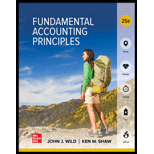
Concept explainers
Concept Introduction:
Cash Flow Statements:
Cash flow statements are an integral part of the financial statements of a company. They reflect the direction and movement of the
Cash flows from Investing activities − The cash inflows refer to sales and income from investing activities and cash outflows include cash outflows from the investing activities in the form of purchase of fixed assets and investments.
Cash flows from Financing activities − The cash inflows refer to income from financing activities such as raising share capital and debt and cash outflows include cash outflows from the financing activities in the form of dividends and interest paid.
There are two methods of preparing cash flow statements:
Direct Method − It measures the actual cash inflows and cash outflows that are affected during a particular reporting period. The actual cash flows do not include non-cash items and items that are recorded owing to the accrual principle.
Indirect Method −It measures the cash inflows and cash outflows that are affected during a particular reporting period including the non-cash items and items that are recorded owing to the accrual principle.
Requirement 1:
Cash flow statements using direct method.
Concept Introduction:
Cash Flow Statements:
Cash flow statements are an integral part of the financial statements of a company. They reflect the direction and movement of the cash inflows and outflows during a reporting period. The cash inflows and outflows are segregated into the following activities:
Cash flows from Operating activities − The cash inflows refer to sales and income from operating activities and cash outflows include both cash and non-cash outflows from the operating activities i.e. the day to day activities of the business.
Cash flows from Investing activities − The cash inflows refer to sales and income from investing activities and cash outflows include cash outflows from the investing activities in the form of purchase of fixed assets and investments.
Cash flows from Financing activities − The cash inflows refer to income from financing activities such as raising share capital and debt and cash outflows include cash outflows from the financing activities in the form of dividends and interest paid.
There are two methods of preparing cash flow statements:
Direct Method − It measures the actual cash inflows and cash outflows that are affected during a particular reporting period. The actual cash flows do not include non-cash items and items that are recorded owing to the accrual principle.
Indirect Method −It measures the cash inflows and cash outflows that are affected during a particular reporting period including the non-cash items and items that are recorded owing to the accrual principle.
Requirement 2:
- Largest inflows and outflows from the activities of the cash flow statement
- Largest individual item from the investing activities
- Whether cash proceeds are higher from issuance of notes or issuance of stocks
- If cash flows from borrowings are inflows or outflows
Want to see the full answer?
Check out a sample textbook solution
Chapter 16 Solutions
FUND.ACCT.PRIN.
- Which financial statement reports revenues and expenses over a period of time?A) Balance SheetB) Cash Flow StatementC) Income StatementD) Statement of Retained Earningsneed help !arrow_forwardHow much is cash received from customer for the year?arrow_forwardConsider the following information for Cortex industries and calculate the gross profit percentage.arrow_forward
- Ikea Software Inc. reported sales revenue of $92,300 on its income statement. The accounts receivable balance increased by $4,700 over the year. Determine the amount of cash received from customers.arrow_forwardgeneral accountingarrow_forwardCan you solve this general accounting problem with appropriate steps and explanations?arrow_forward
- During a period of time, Eleanor Digital Corporation reported that total liabilities increased by $47,600 and stockholders' equity decreased by $12,900. By what amount and direction must total assets change during that same period? a) $34,700 increase b) $60,500 increase c) $34,700 decrease d) $60,500 decreasearrow_forwardPlease provide the accurate answer to this general accounting problem using valid techniques.arrow_forwardI need help with this solution and accountingarrow_forward

 AccountingAccountingISBN:9781337272094Author:WARREN, Carl S., Reeve, James M., Duchac, Jonathan E.Publisher:Cengage Learning,
AccountingAccountingISBN:9781337272094Author:WARREN, Carl S., Reeve, James M., Duchac, Jonathan E.Publisher:Cengage Learning, Accounting Information SystemsAccountingISBN:9781337619202Author:Hall, James A.Publisher:Cengage Learning,
Accounting Information SystemsAccountingISBN:9781337619202Author:Hall, James A.Publisher:Cengage Learning, Horngren's Cost Accounting: A Managerial Emphasis...AccountingISBN:9780134475585Author:Srikant M. Datar, Madhav V. RajanPublisher:PEARSON
Horngren's Cost Accounting: A Managerial Emphasis...AccountingISBN:9780134475585Author:Srikant M. Datar, Madhav V. RajanPublisher:PEARSON Intermediate AccountingAccountingISBN:9781259722660Author:J. David Spiceland, Mark W. Nelson, Wayne M ThomasPublisher:McGraw-Hill Education
Intermediate AccountingAccountingISBN:9781259722660Author:J. David Spiceland, Mark W. Nelson, Wayne M ThomasPublisher:McGraw-Hill Education Financial and Managerial AccountingAccountingISBN:9781259726705Author:John J Wild, Ken W. Shaw, Barbara Chiappetta Fundamental Accounting PrinciplesPublisher:McGraw-Hill Education
Financial and Managerial AccountingAccountingISBN:9781259726705Author:John J Wild, Ken W. Shaw, Barbara Chiappetta Fundamental Accounting PrinciplesPublisher:McGraw-Hill Education





